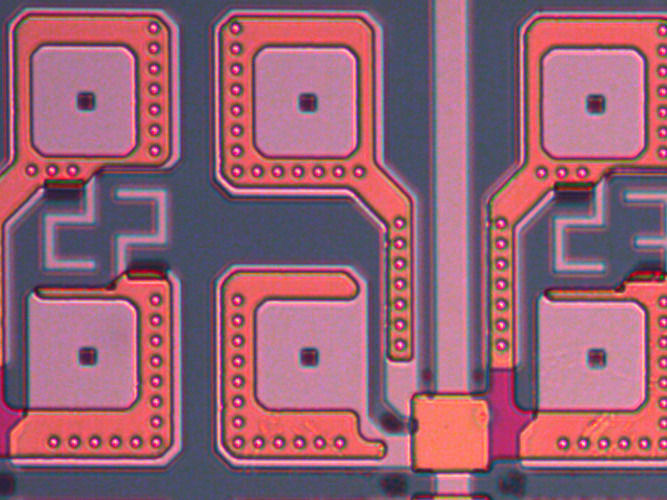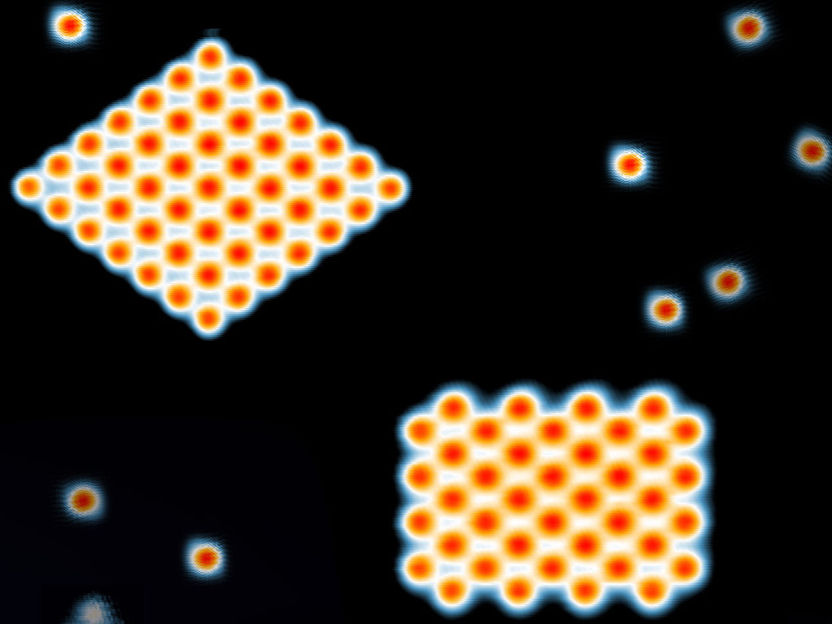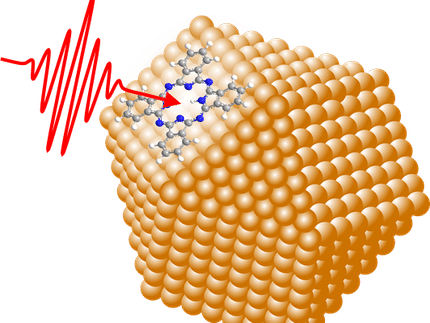Electrical contact to molecules in semiconductor structures established for the first time
Electrical circuits are constantly being scaled down and extended with specific functions. A new method now allows electrical contact to be established with simple molecules on a conventional silicon chip. The technique promises to bring advances in sensor technology and medicine, as reported in the journal Nature by chemists from the University of Basel and researchers from IBM Research – Zurich in Rüschlikon.

Tiny pores were filled with molecules and brought into electrical contact via a platinum electrode from below and a gold nanoparticle electrode from above. Section of a silicon wafer containing thousands of pores with contact pads for electrical characterization.
IBM Research – Zurich
To further develop semiconductor technology, the field of molecular electronics is seeking to manufacture circuit components from individual molecules instead of silicon. Because of their unique electronic properties, molecules are suited to applications that cannot be implemented using conventional silicon technology. However, this requires reliable and inexpensive methods for creating electrical contacts at the two ends of a molecule.
The ability to produce thousands of elements
Researchers from the University of Basel and IBM Research – Zurich have now developed a technique that allows electrical contact to individual molecules to be established. Thousands of stable metal-molecule-metal components can be produced simultaneously by depositing a film of nanoparticles onto the molecules, without compromising the properties of the molecules. This approach was demonstrated using alkane-dithiol compounds, which are made up of carbon, hydrogen, and sulfur.
The researchers used a type of sandwich construction in which an interlayer of molecules is brought into contact with metallic electrodes from above and below. The lower electrode consists of a layer of platinum, which is coated with a layer of non-conducting material. Tiny pores are then etched into this layer to produce arbitrary patterns of compartments of different sizes, inside which there is an electrical contact with the platinum electrode.
Self-assembled monolayers
The researchers then took advantage of the ability of certain molecules to self-assemble. Onto the pattern of pores, they applied a solution containing alkane-dithiol molecules, which self-assemble into the pores, forminga densely packed monolayer film. Within this film, the individual molecules exhibit a regular arrangement and an electrical connection with the lower platinum electrode. Electrical contact with the molecular layer is established via an upper electrode made of gold nanoparticles.
The new technique largely resolves the issues that previously hampered the creation of electrical contacts to molecules – such as high contact resistance or short circuits by filaments penetrating the film. Building blocks fabricated by this method can be operated under standard conditions and provide long-term stability. Moreover, the method can be applied to a variety of other molecular systems and opens up new avenues for integrating molecular compounds into solid-state devices. Its applications could include new types of instruments in the fields of sensor technology and medicine.
“Our approach will help speed up the development of chemically fabricated and controllable electronic and sensor components,” says Professor Marcel Mayor of the Department of Chemistry at the University of Basel. The project received significant funding from the National Center of Competence in Research (NCCR) for Molecular Systems Engineering, in which the University of Basel and ETH Zurich are leading houses.
Original publication
Other news from the department science
These products might interest you

NANOPHOX CS by Sympatec
Particle size analysis in the nano range: Analyzing high concentrations with ease
Reliable results without time-consuming sample preparation

Eclipse by Wyatt Technology
FFF-MALS system for separation and characterization of macromolecules and nanoparticles
The latest and most innovative FFF system designed for highest usability, robustness and data quality

DynaPro Plate Reader III by Wyatt Technology
Screening of biopharmaceuticals and proteins with high-throughput dynamic light scattering (DLS)
Efficiently characterize your sample quality and stability from lead discovery to quality control

Get the chemical industry in your inbox
By submitting this form you agree that LUMITOS AG will send you the newsletter(s) selected above by email. Your data will not be passed on to third parties. Your data will be stored and processed in accordance with our data protection regulations. LUMITOS may contact you by email for the purpose of advertising or market and opinion surveys. You can revoke your consent at any time without giving reasons to LUMITOS AG, Ernst-Augustin-Str. 2, 12489 Berlin, Germany or by e-mail at revoke@lumitos.com with effect for the future. In addition, each email contains a link to unsubscribe from the corresponding newsletter.
Most read news
More news from our other portals
Last viewed contents
Category:Fibrates
Category:Bismuth_minerals
Monolayer
Van_der_Waals_radius
Category:Substitution_reactions
Tyrocidine
Porphyry_(geology)
Duane_Reade
Donald_G._Herbe,_Sr.




























































